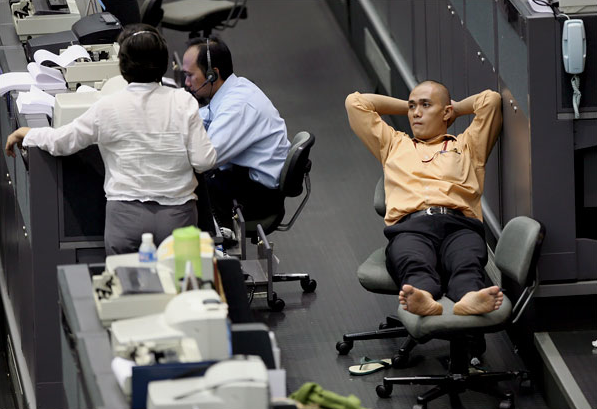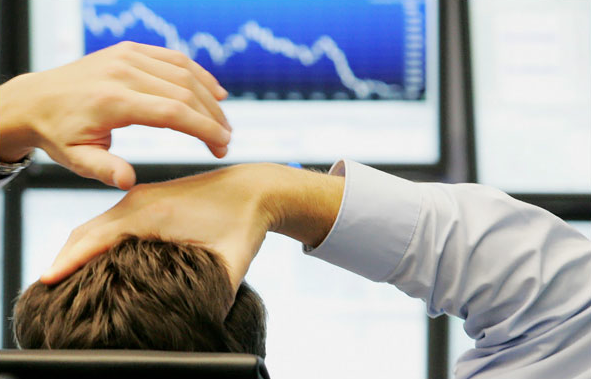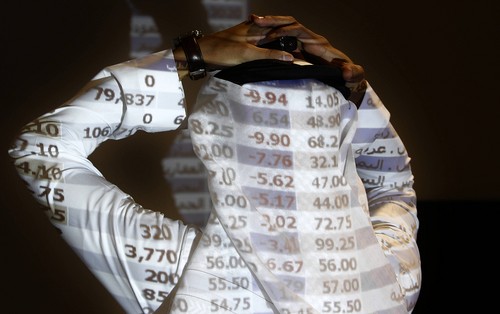The collapse of the global financial markets is difficult to understand in part because it is difficult to visualize. That may be why there have been so many photographs of traders in various states of consternation or dismay. The shot is so conventional that photographers always are looking for a fresh angle, like this:
The trader on the right is literally laying down on the job. His more conventional associates don’t mind, however, because there is no longer a job to do. They might try to drone down into the disaster, but this guy knows better. That isn’t going to save him, however. He also looks like he’s laid out on a hospital gurney: the skin tone of his bare feet is picked up by the flesh colored shirt and bare head to suggest the vulnerability and dependency we experience when wearing a patient’s smock. He could be looking at his X-rays before they put him under. He’s cool but not in control; he’s just comfortable with not being in control.
The contrast between the the bare-footed patient and his environment pervades the image. Amidst the institutional decor, messy array of machines and printouts, and cyborg workers, he looks like a human being. The photo is unusual in featuring his composure, but still conventional in that it brings the global, systemic, structural collapse down to human scale. As does this:
From feet to hands, but to the same effect. Like the image above, this is both a conventional photo and an attempt to be distinctive. Just as there are many shots of trading floors littered with equipment and distracted traders, so are there many photos of people staring into screens that bear only bad news. And just as the first photo was keyed by those bare feet, here the trader’s hands define the picture. He, too, has stopped working–leaning back to hold his head as if it to keep in place while he watches the disaster unfold. Hands are symbols of work, and his have been taken off the task. They can’t stop the lethal dive depicted on the screen. Even so, they are young, strong, capable hands. The photo may be reassuring after all.
There is much to not like about the convention of reducing collective trauma to images of traders reacting to the news. The images are highly gendered, fragmentary depictions of isolated individuals. Anything like a social fabric or common good is left to the mise en scene of the market–what most of us would consider a seriously mistaken substitution. Worse, perhaps, the harm that will in fact be distributed across millions of lives for years to come is localized–as if only these guys are bearing the brunt of the crash.
The public often has to make do with less than optimal resources for understanding and judgment. These images have their problems, but they also may be an attempt to put a human face–and feet and hands–on the problem. Seeing the disaster as the operation of an alien system with its own harsh logic can only make the problem worse, destroying political will and accountability alike. These images are performances of the body politic–albeit the fragmented body politic of a liberal society–and they each offer a slightly different perspective and varied means for grasping and responding to the crisis.
But good theater will not always be reassuring. So it is that I’ll close with this image.
The intention to capture a distinctive image may seem to be all there is to the photo, but there is more. The hands on head cue attitudes of dismay and capability just as in the image above. This time, however, the economic data are not set apart from the trader, not placed in a safe distance in the background (or off screen as in the first photo). While looking at a screen, he has become a screen. Although still caught up in his human choreography, he appears completely subsumed under the operation of an alien system with its own harsh logic. This is not so reassuring.
And so we need other resources for dealing with our fate. Humor, for example. In this case, an excellent post labeled Sad Guys on Trading Floors. Dozens of photos, each with a clever caption. Enjoy the show.
Update: See also Images of a Crisis? at Spiegel online; the link comes courtesy of Conscientious. And here’s another variation on the theme: Traders with Hands on their Faces.
Photographs by Adi Weda/European Pressphoto Agency, Martin Oeser/Agence France-Presse-Getty Images, and Hassan Anmar/Associated Press.



[…] that economic traumas are not nearly as easy to visualize as wars or natural disasters. And the result is somewhat amusing as one after another the various newspapers emphasize an almost endless parade […]
Just as there are many shots of trading floors littered with equipment and distracted traders, so are there many photos of people staring into screens that bear only bad news.